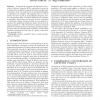Free Online Productivity Tools
i2Speak
i2Symbol
i2OCR
iTex2Img
iWeb2Print
iWeb2Shot
i2Type
iPdf2Split
iPdf2Merge
i2Bopomofo
i2Arabic
i2Style
i2Image
i2PDF
iLatex2Rtf
Sci2ools
ECAI
2006
Springer
2006
Springer
Possibilistic Influence Diagrams
Abstract. In this article we present the framework of Possibilistic Influence Diagrams (PID), which allow to model in a compact form problems of sequential decision making under uncertainty, when only ordinal data on transitions likelihood or preferences are available. The graphical part of a PID is exactly the same as that of usual influence diagrams, however the semantics differ. Transition likelihoods are expressed as possibility distributions and rewards are here considered as satisfaction degrees. Expected utility is then replaced by anyone of two possibilistic qualitative utility criteria for evaluating strategies in a PID. We describe a decision tree-based method for evaluating PID and computing optimal strategies. We then study the computational complexity of PID-related problems (computation of the value of a policy, computation of an optimal policy).
Artificial Intelligence | ECAI 2006 | Influence Diagrams | Possibilistic Influence Diagrams | Possibilistic Qualitative Utility |
Related Content
| Added | 22 Aug 2010 |
| Updated | 22 Aug 2010 |
| Type | Conference |
| Year | 2006 |
| Where | ECAI |
| Authors | Laurent Garcia, Régis Sabbadin |
Comments (0)

